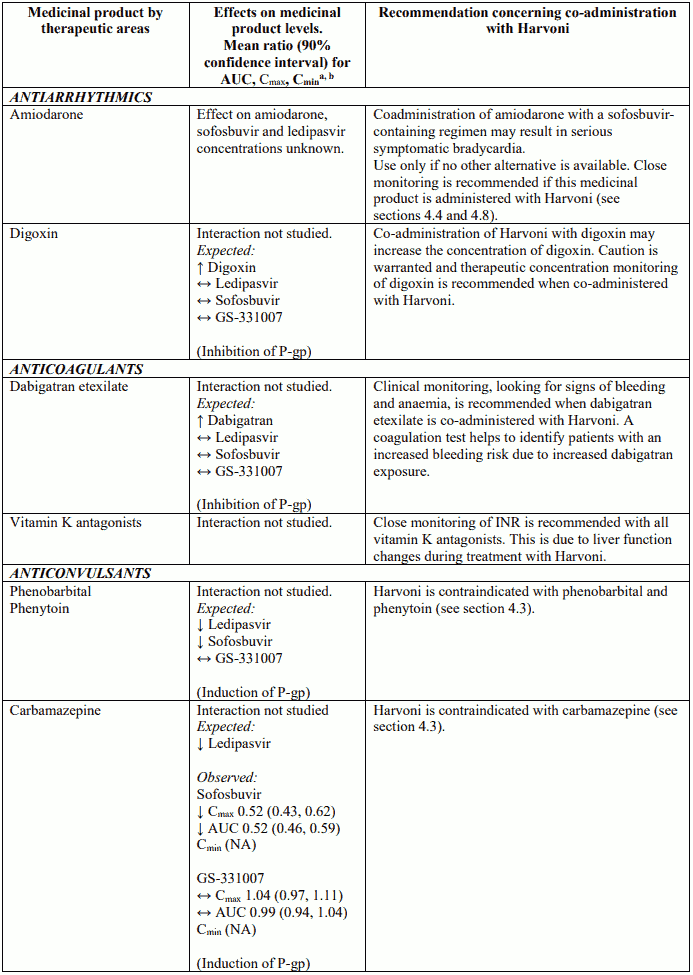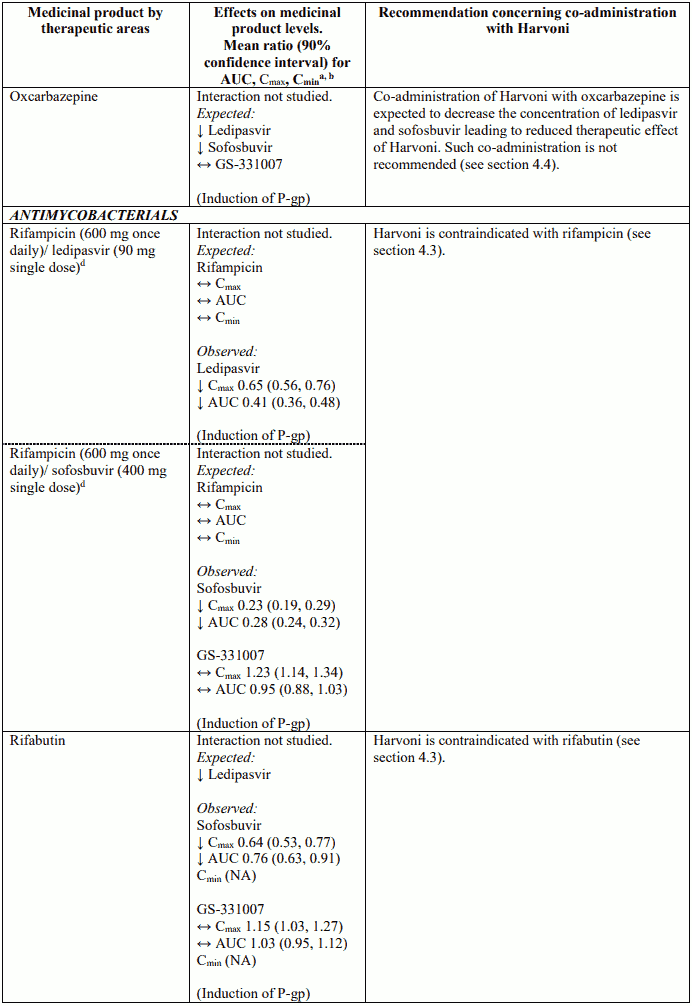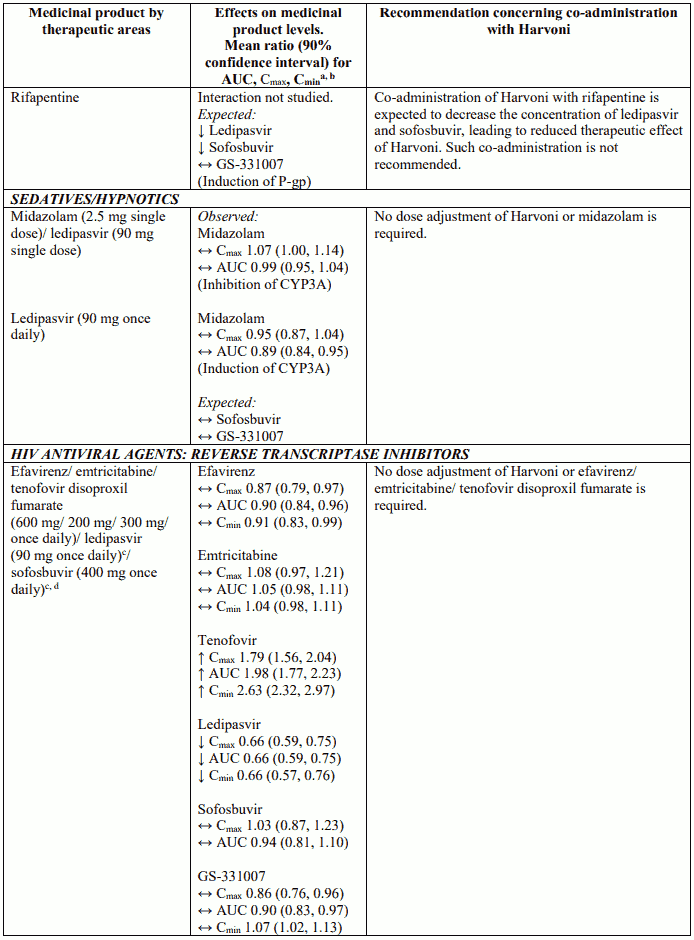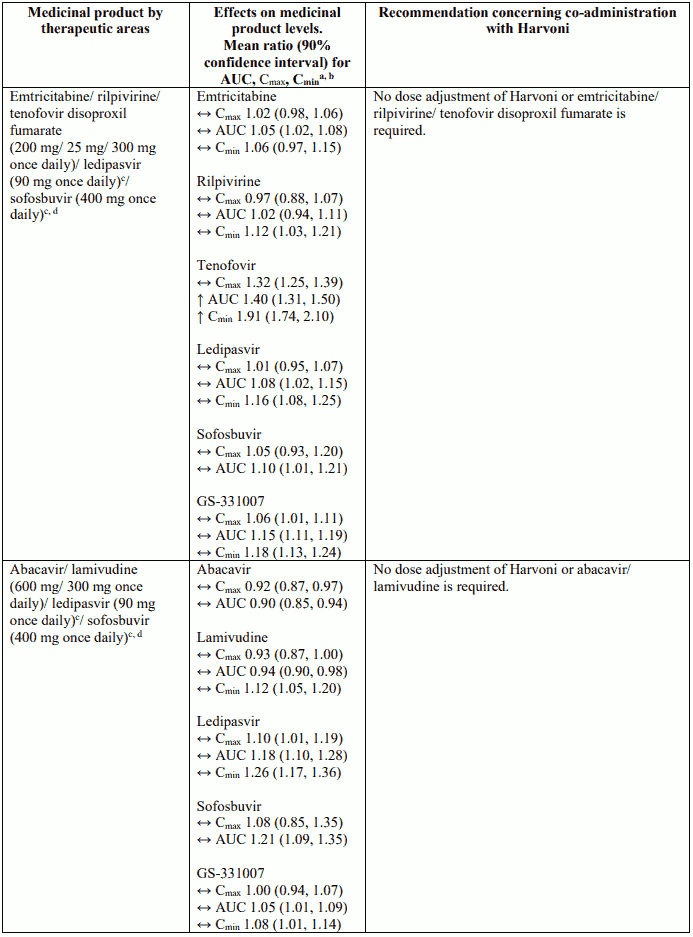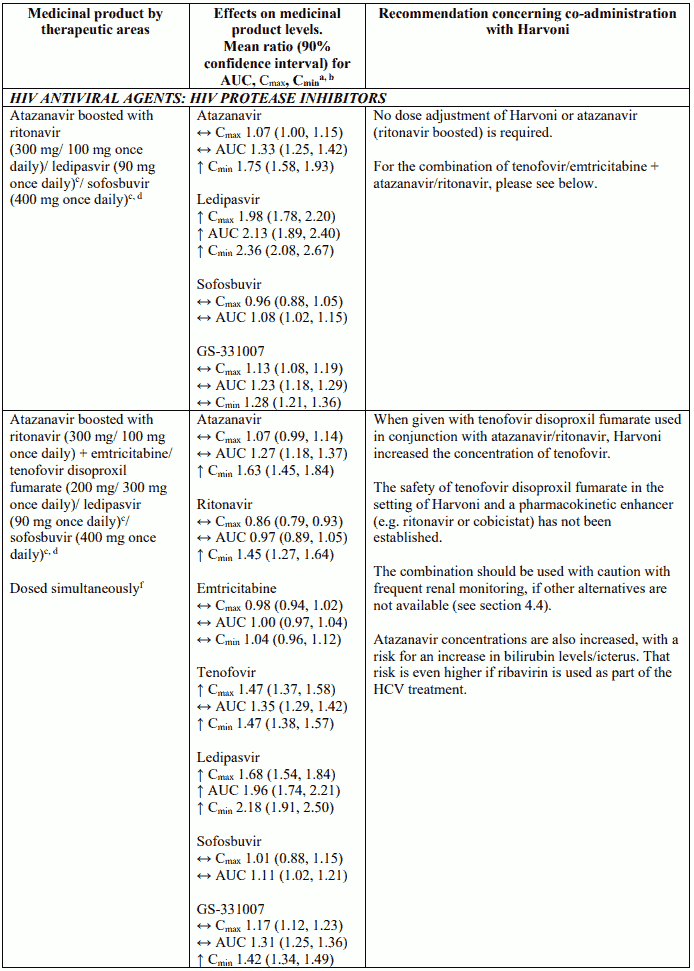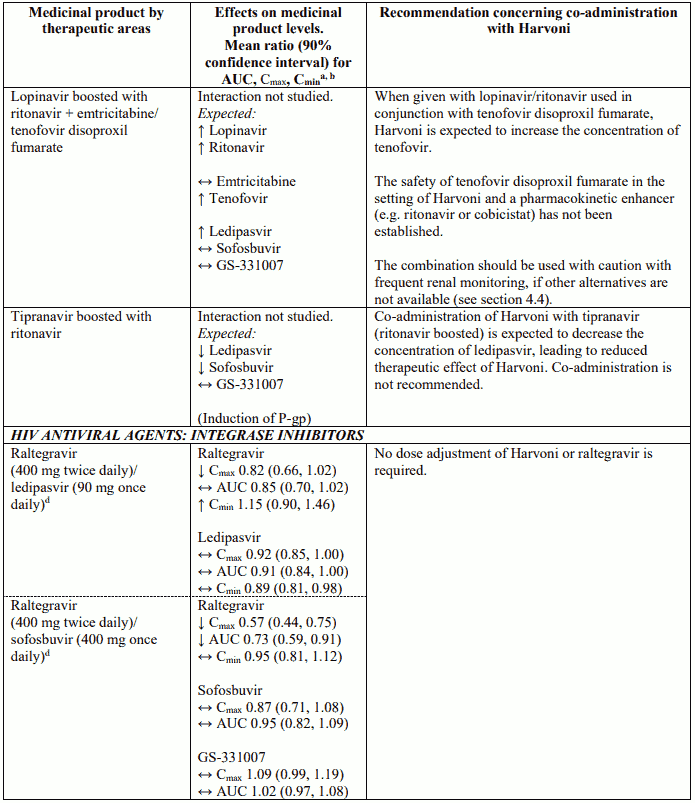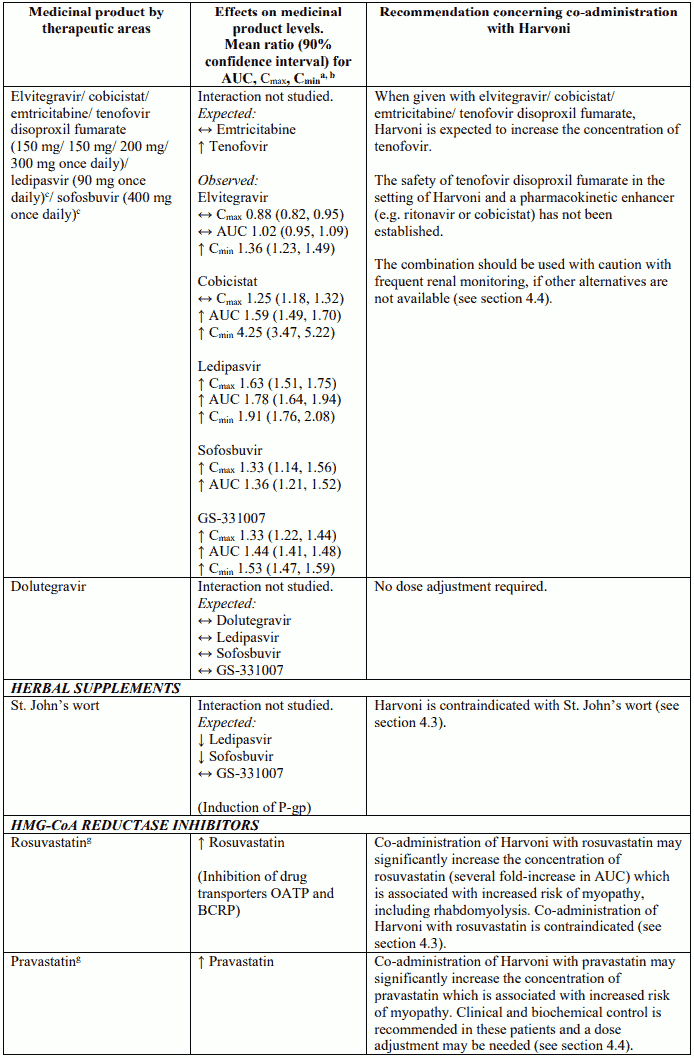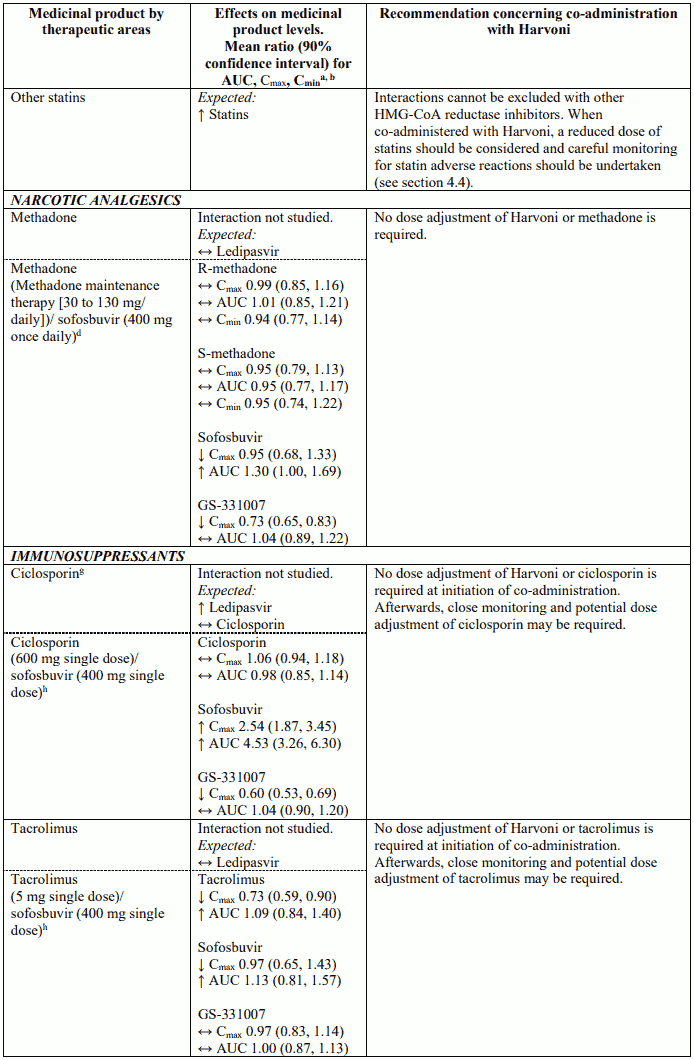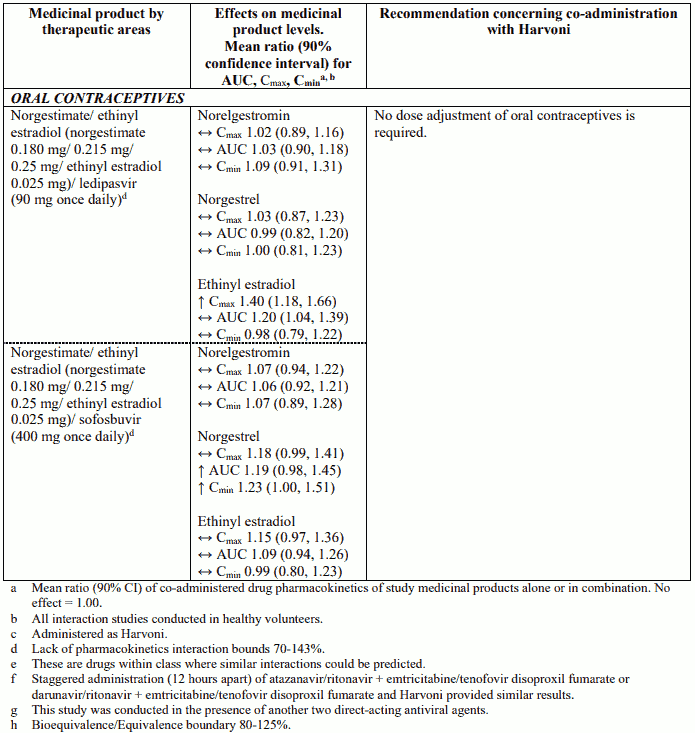HARVONI Coated granules Ref.[51279] Active ingredients: Sofosbuvir and Ledipasvir
Source: European Medicines Agency (EU) Revision Year: 2022 Publisher: Gilead Sciences Ireland UC, Carrigtohill, County Cork, T45 DP77, Ireland
4.3. Contraindications
Hypersensitivity to the active substances or to any of the excipients listed in section 6.1.
Co-administration with rosuvastatin (see section 4.5).
Use with strong P-gp inducers
Medicinal products that are strong P-glycoprotein (P-gp) inducers in the intestine (carbamazepine, phenobarbital, phenytoin, rifampicin, rifabutin and St. John’s wort). Co-administration will significantly decrease ledipasvir and sofosbuvir plasma concentrations and could result in loss of efficacy of Harvoni (see section 4.5).
4.4. Special warnings and precautions for use
Harvoni should not be administered concomitantly with other medicinal products containing sofosbuvir.
Genotype-specific activity
Concerning recommended regimens with different HCV genotypes, see section 4.2. Concerning genotype-specific virological and clinical activity, see section 5.1.
The clinical data to support the use of Harvoni in adults infected with HCV genotype 3 are limited (see section 5.1). The relative efficacy of a 12-week regimen consisting of ledipasvir/sofosbuvir + ribavirin, compared to a 24-week regimen of sofosbuvir + ribavirin has not been investigated. A conservative 24 weeks of therapy is advised in all treatment-experienced genotype 3 patients and those treatment-naïve genotype 3 patients with cirrhosis (see section 4.2). In genotype 3-infection, the use of Harvoni (always in combination with ribavirin) should only be considered for patients who are deemed at high risk for clinical disease progression and who do not have alternative treatment options.
The clinical data to support the use of Harvoni in adults infected with HCV genotype 2 and 6 are limited (see section 5.1).
Severe bradycardia and heart block
Life-threatening cases of severe bradycardia and heart block have been observed when sofosbuvircontaining regimens are used in combination with amiodarone. Bradycardia has generally occurred within hours to days, but cases with a longer time to onset have been observed mostly up to 2 weeks after initiating HCV treatment.
Amiodarone should only be used in patients on Harvoni when other alternative anti-arrhythmic treatments are not tolerated or are contraindicated.
Should concomitant use of amiodarone be considered necessary it is recommended that patients undergo cardiac monitoring in an in-patient setting for the first 48 hours of coadministration, after which outpatient or self-monitoring of the heart rate should occur on a daily basis through at least the first 2 weeks of treatment.
Due to the long half-life of amiodarone, cardiac monitoring as outlined above should also be carried out for patients who have discontinued amiodarone within the past few months and are to be initiated on Harvoni.
All patients with concurrent or recent use of amiodarone should be warned of the symptoms of bradycardia and heart block and should be advised to seek medical advice urgently should they experience them.
Use in diabetic patients
Diabetics may experience improved glucose control, potentially resulting in symptomatic hypoglycaemia, after initiating HCV direct-acting antiviral treatment. Glucose levels of diabetic patients initiating direct-acting antiviral therapy should be closely monitored, particularly within the first 3 months, and their diabetic medication modified when necessary. The physician in charge of the diabetic care of the patient should be informed when direct-acting antiviral therapy is initiated.
HCV/HBV (hepatitis B virus) co-infection
Cases of hepatitis B virus (HBV) reactivation, some of them fatal, have been reported during or after treatment with direct-acting antiviral agents. HBV screening should be performed in all patients before initiation of treatment. HBV/HCV co-infected patients are at risk of HBV reactivation, and should therefore be monitored and managed according to current clinical guidelines.
Treatment of patients with prior exposure to HCV direct-acting antivirals
In patients who fail treatment with ledipasvir/sofosbuvir, selection of NS5A resistance mutations that substantially reduce the susceptibility to ledipasvir is seen in the majority of cases (see section 5.1). Limited data indicate that such NS5A mutations do not revert on long-term follow-up. There are presently no data to support the effectiveness of retreatment of patients who have failed ledipasvir/sofosbuvir with a subsequent regimen that contains an NS5A inhibitor. Similarly, there are presently no data to support the effectiveness of NS3/4A protease inhibitors in patients who previously failed prior therapy that included an NS3/4A protease inhibitor. Such patients may therefore be dependent on other classes of medicinal products for clearance of HCV infection. Consequently, consideration should be given to longer treatment for patients with uncertain subsequent retreatment options.
Renal impairment
Safety data are limited in patients with severe renal impairment (estimated glomerular filtration rate [eGFR] <30 mL/min/1.73m²) and ESRD requiring haemodialysis. Harvoni can be used in these patients with no dose adjustment when no other relevant treatment options are available (see sections 4.8, 5.1 and 5.2). When Harvoni is used in combination with ribavirin refer also to the Summary of Product Characteristics for ribavirin for patients with creatinine clearance (CrCl) <50 mL/min (see section 5.2).
Adults with decompensated cirrhosis and/or who are awaiting liver transplant or post-liver transplant
The efficacy of ledipasvir/sofosbuvir in genotype 5 and genotype 6 HCV-infected patients with decompensated cirrhosis and/or who are awaiting liver transplant or post-liver transplant has not been investigated. Treatment with Harvoni should be guided by an assessment of the potential benefits and risks for the individual patient.
Use with moderate P-gp inducers
Medicinal products that are moderate P-gp inducers in the intestine (e.g. oxcarbazepine) may decrease ledipasvir and sofosbuvir plasma concentrations leading to reduced therapeutic effect of Harvoni. Co-administration of such medicinal products is not recommended with Harvoni (see section 4.5).
Use with certain HIV antiretroviral regimens
Harvoni has been shown to increase tenofovir exposure, especially when used together with an HIV regimen containing tenofovir disoproxil fumarate and a pharmacokinetic enhancer (ritonavir or cobicistat). The safety of tenofovir disoproxil fumarate in the setting of Harvoni and a pharmacokinetic enhancer has not been established. The potential risks and benefits associated with co-administration of Harvoni with the fixed-dose combination tablet containing elvitegravir/cobicistat/emtricitabine/tenofovir disoproxil fumarate or tenofovir disoproxil fumarate given in conjunction with a boosted HIV protease inhibitor (e.g. atazanavir or darunavir) should be considered, particularly in patients at increased risk of renal dysfunction. Patients receiving Harvoni concomitantly with elvitegravir/cobicistat/emtricitabine/tenofovir disoproxil fumarate or with tenofovir disoproxil fumarate and a boosted HIV protease inhibitor should be monitored for tenofovirassociated adverse reactions. Refer to tenofovir disoproxil fumarate, emtricitabine/tenofovir disoproxil fumarate, or elvitegravir/cobicistat/emtricitabine/tenofovir disoproxil fumarate Summary of Product Characteristics for recommendations on renal monitoring.
Use with HMG-CoA reductase inhibitors
Co-administration of Harvoni and HMG-CoA reductase inhibitors (statins) can significantly increase the concentration of the statin, which increases the risk of myopathy and rhabdomyolysis (see section 4.5).
Paediatric population
Harvoni is not recommended for use in paediatric patients aged <3 years because the safety and efficacy have not been established in this population.
Excipients
Harvoni contains the azo colouring agent sunset yellow FCF (E110), which may cause allergic reactions. It also contains lactose. Patients with rare hereditary problems of galactose intolerance, total lactase deficiency, or glucose-galactose malabsorption should not take this medicinal product.
This medicine contains less than 1 mmol sodium (23 mg) per tablet, that is to say essentially ‘sodium-free’.
4.5. Interaction with other medicinal products and other forms of interaction
As Harvoni contains ledipasvir and sofosbuvir, any interactions that have been identified with these active substances individually may occur with Harvoni.
Potential for Harvoni to affect other medicinal products
Ledipasvir is an in vitro inhibitor of drug transporter P-gp and breast cancer resistance protein (BCRP) and may increase intestinal absorption of co-administered substrates for these transporters.
Potential for other medicinal products to affect Harvoni
Ledipasvir and sofosbuvir are substrates of drug transporter P-gp and BCRP while GS-331007 is not.
Medicinal products that are strong P-gp inducers (carbamazepine, phenobarbital, phenytoin, rifampicin, rifabutin and St. John’s wort) may significantly decrease ledipasvir and sofosbuvir plasma concentrations leading to reduced therapeutic effect of ledipasvir/sofosbuvir and thus are contraindicated with Harvoni (see section 4.3).
Medicinal products that are moderate P-gp inducers in the intestine (e.g. oxcarbazepine) may decrease ledipasvir and sofosbuvir plasma concentrations leading to reduced therapeutic effect of Harvoni. Co-administration with such medicinal products is not recommended with Harvoni (see section 4.4). Co-administration with medicinal products that inhibit P-gp and/or BCRP may increase ledipasvir and sofosbuvir plasma concentrations without increasing GS-331007 plasma concentration; Harvoni may be co-administered with P-gp and/or BCRP inhibitors. Clinically significant medicinal product interactions with ledipasvir/sofosbuvir mediated by CYP450s or UGT1A1 enzymes are not expected.
Patients treated with vitamin K antagonists
As liver function may change during treatment with Harvoni, a close monitoring of International Normalised Ratio (INR) values is recommended.
Impact of DAA therapy on drugs metabolized by the liver
The pharmacokinetics of drugs that are metabolized by the liver (e.g. immunosuppressive agents such as calcineurin inhibitors) may be impacted by changes in liver function during DAA therapy, related to clearance of HCV virus.
Interactions between Harvoni and other medicinal products
Table 6 provides a listing of established or potentially clinically significant medicinal product interactions (where 90% confidence interval [CI] of the geometric least-squares mean [GLSM] ratio were within “↔”, extended above “↑”, or extended below “↓” the predetermined equivalence boundaries). The medicinal product interactions described are based on studies conducted with either ledipasvir/sofosbuvir or ledipasvir and sofosbuvir as individual agents, or are predicted medicinal product interactions that may occur with ledipasvir/sofosbuvir. The table is not all-inclusive.
Table 6. Interactions between Harvoni and other medicinal products:
4.6. Pregnancy and lactation
Women of childbearing potential / contraception in males and females
When Harvoni is used in combination with ribavirin, extreme care must be taken to avoid pregnancy in female patients and in female partners of male patients. Significant teratogenic and/or embryocidal effects have been demonstrated in all animal species exposed to ribavirin. Women of childbearing potential or their male partners must use an effective form of contraception during treatment and for a period of time after the treatment has concluded as recommended in the Summary of Product Characteristics for ribavirin. Refer to the Summary of Product Characteristics for ribavirin for additional information.
Pregnancy
There are no or limited amount of data (less than 300 pregnancy outcomes) from the use of ledipasvir, sofosbuvir or Harvoni in pregnant women.
Animal studies do not indicate direct harmful effects with respect to reproductive toxicity. No significant effects on foetal development have been observed with ledipasvir or sofosbuvir in rats and rabbits. However, it has not been possible to fully estimate exposure margins achieved for sofosbuvir in the rat relative to the exposure in humans at the recommended clinical dose (see section 5.3).
As a precautionary measure, it is preferable to avoid the use of Harvoni during pregnancy.
Breast-feeding
It is unknown whether ledipasvir or sofosbuvir and its metabolites are excreted in human milk.
Available pharmacokinetic data in animals has shown excretion of ledipasvir and metabolites of sofosbuvir in milk (see section 5.3).
A risk to the newborns/infants cannot be excluded. Therefore, Harvoni should not be used during breast-feeding.
Fertility
No human data on the effect of Harvoni on fertility are available. Animal studies do not indicate harmful effects of ledipasvir or sofosbuvir on fertility.
If ribavirin is co-administered with Harvoni, the contraindications regarding use of ribavirin during pregnancy and breast-feeding apply (see also the Summary of Product Characteristics for ribavirin).
4.7. Effects on ability to drive and use machines
Harvoni (administered alone or in combination with ribavirin) has no or negligible influence on the ability to drive and use machines. However, patients should be advised that fatigue was more common in patients treated with ledipasvir/sofosbuvir compared to placebo.
4.8. Undesirable effects
Summary of the safety profile in adults
The safety assessment of Harvoni was mainly based on pooled Phase 3 clinical studies, without a control, in 1952 patients who received Harvoni for 8, 12 or 24 weeks, including 872 patients who received Harvoni in combination with ribavirin.
The proportion of patients who permanently discontinued treatment due to adverse events was 0%, <1% and 1% for patients receiving ledipasvir/sofosbuvir for 8, 12 and 24 weeks, respectively; and <1%, 0%, and 2% for patients receiving ledipasvir/sofosbuvir + ribavirin combination therapy for 8, 12 and 24 weeks, respectively.
In clinical studies, fatigue and headache were more common in patients treated with ledipasvir/sofosbuvir compared to placebo. When ledipasvir/sofosbuvir was studied with ribavirin, the most frequent adverse drug reactions to ledipasvir/sofosbuvir + ribavirin combination therapy were consistent with the known safety profile of ribavirin, without increasing the frequency or severity of the expected adverse drug reactions.
Tabulated list of adverse events
The following adverse drug reactions have been identified with Harvoni (Table 7). The adverse reactions are listed below by body system organ class and frequency. Frequencies are defined as follows: very common (≥1/10), common (≥1/100 to <1/10), uncommon (≥1/1,000 to <1/100), rare (≥1/10,000 to <1/1,000) or very rare (<1/10,000).
Table 7. Adverse drug reactions identified with Harvoni:
| Frequency | Adverse drug reaction |
|---|---|
| Nervous system disorders | |
| Very common | headache |
| Skin and subcutaneous tissue disorders | |
| Common | rash |
| Not known | angioedema |
| General disorders | |
| Very common | fatigue |
Adults with decompensated cirrhosis and/or who are awaiting liver transplant or post-liver transplant
The safety profile of ledipasvir/sofosbuvir with ribavirin for 12 or 24 weeks in adults with decompensated liver disease and/or those post-liver transplant was assessed in two open-label studies (SOLAR-1 and SOLAR-2). No new adverse drug reactions were detected among patients with decompensated cirrhosis and/or who were post-liver transplant and who received ledipasvir/sofosbuvir with ribavirin. Although adverse events, including serious adverse events, occurred more frequently in this study compared to studies that excluded decompensated patients and/or patients who were postliver transplantation, the adverse events observed were those expected as clinical sequelae of advanced liver disease and/or transplantation or were consistent with the known safety profile of ribavirin (see section 5.1 for details of this study).
Decreases in haemoglobin to <10 g/dL and <8.5 g/dL during treatment were experienced by 39% and 13% of patients treated with ledipasvir/sofosbuvir with ribavirin, respectively. Ribavirin was discontinued in 15% of the patients.
7% of liver transplant recipients had a modification of their immunosuppressive agents.
Patients with renal impairment
Ledipasvir/sofosbuvir was administered for 12 weeks to 18 patients with genotype 1 CHC and severe renal impairment in an open-label study (Study 0154). In this limited clinical safety data set, the rate of adverse events was not clearly elevated from what is expected in patients with severe renal impairment.
The safety of Harvoni has been evaluated in a 12-week non-controlled study including 95 patients with ESRD requiring dialysis (Study 4063). In this setting, exposure of sofosbuvir metabolite GS331007 is 20-fold increased, exceeding levels where adverse reactions have been observed in preclinical trials. In this limited clinical safety data set, the rate of adverse events and deaths was not clearly elevated from what is expected in ESRD patients.
Paediatric population
The safety and efficacy of Harvoni in paediatric patients aged 3 years and above are based on data from a Phase 2, open-label clinical study (Study 1116) that enrolled 226 patients who were treated with ledipasvir/sofosbuvir for 12 or 24 weeks or ledipasvir/sofosbuvir plus ribavirin for 24 weeks. The adverse reactions observed were consistent with those observed in clinical studies of ledipasvir/sofosbuvir in adults (see Table 7).
Description of selected adverse reactions
Cardiac arrhythmias
Cases of severe bradycardia and heart block have been observed when Harvoni is used with amiodarone and/or other drugs that lower heart rate (see sections 4.4 and 4.5).
Skin disorders
Frequency not known: Stevens-Johnson syndrome
Reporting of suspected adverse reactions
Reporting suspected adverse reactions after authorisation of the medicinal product is important. It allows continued monitoring of the benefit/risk balance of the medicinal product. Healthcare professionals are asked to report any suspected adverse reactions via the national reporting system listed in Appendix V.
6.2. Incompatibilities
Not applicable.
© All content on this website, including data entry, data processing, decision support tools, "RxReasoner" logo and graphics, is the intellectual property of RxReasoner and is protected by copyright laws. Unauthorized reproduction or distribution of any part of this content without explicit written permission from RxReasoner is strictly prohibited. Any third-party content used on this site is acknowledged and utilized under fair use principles.

